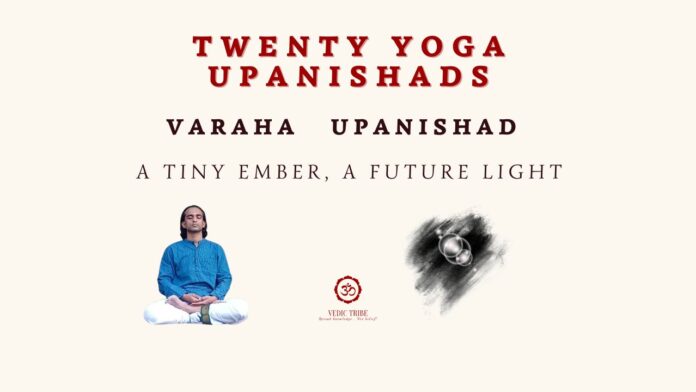A tiny ember, a future light:
In the previous article, we discussed the Mahavakya Upanishad. In this article, we will discuss Varaha Upanishad.
The Varaha Upanishad rebukes ignorant practice of rituals like Upavasa and commands that such rituals should always be seen from the spiritual context. It also contemplates on jeevanmukti, relationship of Jeevatma and paramatma…etc. Its teachings forms parts of Advaita Vedanta.
Tattva:
Three tattvas: In Vedic tradition, all of reality can be divided into three tattva: material world (Prakriti), individual consciousness (Purusha) and supreme consciousness (Parama-purusha).
Expansion of Samkhya: Material world in Samkhya school is divided into 23 gross elements. In Varaha Upanishad, gives further classification models: 24 gross elements, 36 gross elements and 96 gross elements.
Transcending Prakriti: The Upanishad states that the understanding of elements of “Prakriti” should be aimed towards transcending it. The ultimate goal of any Vedic school is liberation from the cycle of Samsara (birth, death, and rebirth). This liberation is achieved by transcending the limitations of Prakriti and realizing the underlying principle – Parabrahman.
Six qualities for higher meditative state:
The Upanishad lays down a rigid six-point approach to acquire a higher meditative state:
Internal Regulation: Regulation of sense organs is fundamentally important for meditation because our senses are constantly drawing our attention outward, away from the inner focus that meditation requires.
External Regulation: – Regulation of limbs of the body is also important because stable & healthy limbs facilitate prolonged meditation. On the other hand, unstable or unhealthy limbs disrupt meditation practices.
Continence: Ceasing all bodily action and sitting stable in a comfortable posture is the crucial step in meditation.
Forbearance: Putting up with heat and cold and other natural & bodily compulsions, becomes important once sadhaka crosses a certain threshold and is able to prolong the time span of meditation.
Sincerity: Adherence to the Vedic teachings is important so that Sadhaka do not deviate from the ultimate goal of liberation.
Meditation: One-pointedness of the mind is an essential element of successful meditation, without which meditation bears no fruit.
Maya – illusion:
This Upanishad gives example of illusion of silver in the shell of pearl-oyster for the illusions created by the material world.
In the context of this Upanishad, the term “maya” is used to indicate false impression or perception of reality.
This is one of the prominent examples used in Advaita Vedanta to assert the proposition that material world is illusory and does not exist.
Key takeaways:
– Study and understand the teachings of this Upanishad and if you are aiming to become advance meditation practitioner, then adopt its teachings.
– Also study Samkhya & Yoga Darshana which will sharpen your mind and help you in progressing in your spiritual path.
The Vedic Tribe is happy to have brought you this series on “twenty Yoga-Upanishads”
Our intention is to revive your interest in this ancient wisdom. By shedding light on these long-forgotten texts, we aim to inspire readers to delve deeper into the rich tapestry of yoga of Vedic tradition. We are sure this creates enough curiosity in you to enable you to study Upanishads and adopt its teachings in your day-to-day life.
All the best.
Madhwesh K
Vedic Tribe

